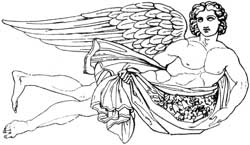Zephyrus

The personification of the west wind, is described by Hesiod1 as a son of Astraeus and Eos. Zephyrus and Boreas are frequently mentioned together by Homer, and both dwelt together in a palace in Thrace.2 By the Harpy Podarge, Zephyrus became the father of the horses Xanthus and Balius, which belonged to Achilles;3 but he was married to Chloris, whom he had carried off by force, and by whom he had a son, Carpus.4
On the sacred road from Athens to Eleusis, there was an altar of Zephyrus.5 See also Anemoi.
❧
Iconography
On the Tower of the Winds (Athens, first century BCE) he is portrayed in relief as a naked, winged youth. He carries spring flowers in the folds of his mantle.
References
Notes
- Theogony, 579.
- Iliad ix, 5; Odyssey v, 295.
- Iliad xvi, 150 ff.
- Ovid. Fasti v, 197; Servius on Virgil's Eclogues v, 48.
- Pausanias. Description of Greece i, 37.1.
Sources
- Aken, Dr. A.R.A. van. (1961). Elseviers Mythologische Encyclopedie. Amsterdam: Elsevier.
- Smith, William. (1870). Dictionary of Greek and Roman Biography and Mythology. London: Taylor, Walton, and Maberly.
This article incorporates text from Dictionary of Greek and Roman Biography and Mythology (1870) by William Smith, which is in the public domain.